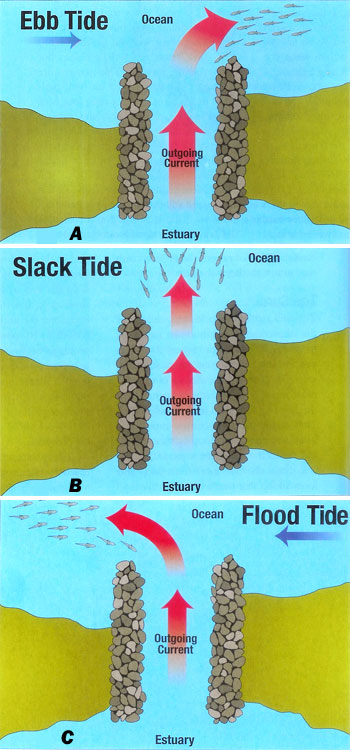A Current Event

The narrow width of an inlet often dictates that the tidal height of a bay lags behind that of the outlying ocean. That difference can cause a strong flow called a hydraulic current through the inlet. Because this flushing action can last an hour or more, the fish-holding areas will shift from one side of the inlet to the other as the ocean progresses from ebb tide (A) to slack tide (B) and finally to flood tide (C).
TIDAL INLETS are one of my favorite areas for fly fishing. By definition, inlets generally connect small estuaries or bays with larger areas of the ocean. They can range in width from a few tens of feet to miles, and they are almost always bounded on either side by jetties.
Because of their relatively narrow opening, inlets generally have strong tidal currents, shifting bottoms, and considerable water turbulence. These bottlenecks will restrict or increase the flow of water between the ocean and an estuary or bay. Because of such dynamic forces, inlets are often prime mixing areas of nutrient-rich salt and fresh water; therefore, they will attract and hold bait. These simple facts are the main reasons why inlets can be excellent places to fish. Depending on where you live, you can find tarpon, redfish, bluefish, stripers, and a host of other species feeding in and around your local pass.
Most readers probably have already fished around many inlets, either from the adjacent jetties or from a boat, and are familiar with some of their peculiarities. Certainly, the key factor to successfully fishing an inlet is an understanding of the local tide and tidal current. One general rule, however, and it is essentially almost always true, is that during a falling or ebbing tide the fishing will be better on the ocean side of an inlet. Likewise, the inside of an inlet is usually better with an incoming or flooding tide. This simply is due to where the bait is being carried.
Tides and tidal currents are very complex phenomena influenced by many things, including the sun and the moon. The big picture and time frames can be determined from consulting tide height and tidal current charts. But each inlet has its own particular rhythm to boot and a fisherman with knowledge of how a local inlet works will increase his or her chances of success.
Hydraulic Currents
The relative size and shape of the bodies water on either side of an inlet greatly influence the tides and tidal currents in that immediate vicinity. Very often, the tidal pattern between the ocean and, say, an estuary is not in phase. In other words, the tide may be flooding on one side of the inlet and ebbing on the other side, and high and low tides can occur at different times. This may initially sound like an impossible situation, but it is very common.
Consider that the immense volume of the ocean is connected to the relatively small volume of an estuary or bay via a narrow channel—the inlet. The flow of water between these two bodies cannot keep pace with the tidal forces, and the result will often be an unequal range in the tide and a lag time between high and low tide on either side. These differences in water height can cause what is called a hydraulic current through the inlet. The question of how long the tidal levels between the two bodies of water are out of phase depends on the strength of the tide, the dimensions of the inlet, the shape of the bay or estuary, and the weather.
The hydraulic effect can result in currents inside the inlet and in the estuary that are considerably different from currents just outside in the ocean. In some places, the difference in the times of the tides between the ocean and the adjacent estuary can be an hour or more. These differences can certainly affect fishing, but if you understand how these hydraulic currents work you can increase your fishing opportunities.
Go With the Flow
Think about the ocean having an ebbing or falling tide, with the tidal current moving from left to right as shown in Figure A. The water in the estuary will also be ebbing, and the outgoing current through the estuary will be deflected to the right when it leaves the inlet because it is being moved by the ebb tidal current in the ocean. At this time, fishing should be better near the right-hand jetty.
Eventually the ocean flow will go slack (see Figure B). However, since the water height in the estuary is still higher than in the ocean, the flow from the estuary (the hydraulic current) will continue to move out through the inlet. Simply stated, the narrowness of the inlet has prevented the estuary from flushing fast enough to keep up with the dropping ocean water. Since there is still water and bait flowing out of the estuary, fishing should now be best directly off the mouth of the inlet.
Eventually the ocean tide will start to flood or rise (see Figure C), but because of the lag effect, the hydraulic current will still be moving out of the estuary. This flow can last an hour or more. In this situation, the outgoing water and bait will be deflected to the left by the flooding ocean tidal current, and fishing should be better near the left hand jetty.
Note that the direction of the flooding and ebbing currents in the ocean may differ depending on where you fish; and if so, make the appropriate adjustment. Also remember that the lag time differs from one inlet to another.
But the bottom line is that the fish around these structures are simply following the bait. Using the above example, you can oftentimes anticipate how, when, and where the action will move throughout the day.











